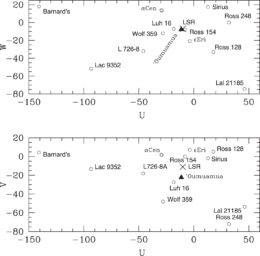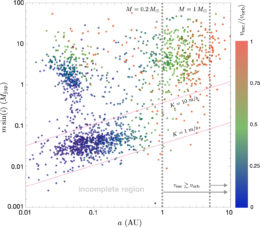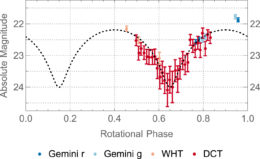What’s the news coming from the research world on the interstellar asteroid visitor, asteroid 1I/’Oumuamua? Read on for an update from a few of the latest studies.
What is ‘Oumuamua?
In late October 2017, the discovery of minor planet 1I/’Oumuamua was announced. This body — which researchers first labeled as a comet and later revised to an asteroid — had just zipped around the Sun and was already in the process of speeding away when we trained our telescopes on it. Its trajectory, however, marked it as being a visitor from outside our solar system: the first known visitor of its kind.
Since ‘Oumuamua’s discovery, scientists have been gathering as many observations of this body as possible before it vanishes into the distance. Simultaneously, theorists have leapt at the opportunity to explain its presence and the implications its passage has on our understanding of our surroundings. Here we present just a few of the latest studies that have been published on this first detected interstellar asteroid — including several timely studies published in our new journal, Research Notes of the AAS.

The galactic velocity of ‘Oumuamua does not coincide with any of the nearest stars to us. [Mamajek 2018]
Where Did ‘Oumuamua Come From?
Are we sure ‘Oumuamua didn’t originate in our solar system and get scattered into a weird orbit? Jason Wright (The Pennsylvania State University) demonstrates via a series of calculations that no known solar system body could have scattered ‘Oumuamua onto its current orbit — nor could any still unknown object bound to our solar system.
Eric Mamajek (Caltech and University of Rochester) shows that the kinematics of ‘Oumuamua are consistent with what we might expect of interstellar field objects, though he argues that its kinematics suggest it’s unlikely to have originated from many of the nearest stellar systems.
What Are ‘Oumuamua’s Properties?
A team of University of Maryland scientists led by Matthew Knight captured a light curve of ‘Oumuamua using Lowell Observatory’s 4.3-m Discovery Channel Telescope. The data indicate that the asteroid’s period is at least 3 hours in length, and most likely more than 5 hours. Assuming the light curve’s variation is caused by the tumbling asteroid’s changing cross-section, ‘Oumuamua must be a minimum of 3 times as long as it is wide. Knight and collaborators see no signs in their images of a coma or tail emitted from ‘Oumuamua, suggesting there is no volatile material sublimating from its surface under the heat of the Sun. A study of the asteroid’s photometry, led by Michele Bannister (Queen’s University Belfast, UK), used the Gemini-North telescope in Hawaii and the William Herschel Telescope in Spain to explore the asteroid’s shape and color. Bannister and collaborators refined the estimate of the asteroid’s shape to be at least 5.3 times as long as it is wide, which requires this body to have significant internal cohesion to hold together as it tumbles. Their measured color for ‘Oumuamua is largely neutral.What Does This Visitor Imply?

Masses and semimajor axes of known exoplanets. Colors correspond to the ratio of escape velocity to circular velocity. The presence of ‘Oumuamua implies a vast and cool, still undetected population of planets. [Laughlin & Batygin, 2017]
More information on ‘Oumuamua is sure to come in the next few months as scientists continue to process their data from the asteroid’s swift passage. In the meantime, this interstellar visitor continues to challenge our understanding of our nearby surroundings and the broader context of the galaxy around us.
Citation
Jason T. Wright 2017 Res. Notes AAS 1 38. doi:10.3847/2515-5172/aa9f23
Eric Mamajek 2017 Res. Notes AAS 1 21. doi:10.3847/2515-5172/aa9bdc
Matthew M. Knight et al 2017 ApJL 851 L31. doi:10.3847/2041-8213/aa9d81
Michele T. Bannister et al 2017 ApJL 851 L38. doi:10.3847/2041-8213/aaa07c
Gregory Laughlin and Konstantin Batygin 2017 Res. Notes AAS 1 43. doi:10.3847/2515-5172/aaa02b




5 Comments
Pingback: Update on an Interstellar Asteroid – MeasurementDataBases for Industry & Science
Pingback: 'Oumuamua's Many Cousins | Andy-Lloyd.comAndy-Lloyd.com
Pingback: Weitere Artikel dieses Bloggers seit Dezember | Skyweek Zwei Punkt Null
Pingback: Revisiting Interstellar Asteroid ‘Oumuamua
Pingback: Two More Explanations for Interstellar Asteroid ‘Oumuamua